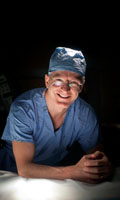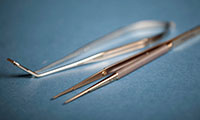Scanlan Instruments
Surgical Instruments Specifically Designed for Off-Pump Coronary Bypass
Skim through the Scanlan International surgical instrument catalog and John Puskas's name emerges frequently: The Puskas micro-scissors, long and slender, with angled fine blades. The Never Shear Dual Guide titanium forceps, "design developed in cooperation with John D. Puskas." The Scanlan Puskas "Black Knight" Lillehei-Potts Scissors.
These medical devices started out as custom instruments for cardiac surgeon John Puskas, MD, professor of thoracic surgery at Emory's School of Medicine, to use in his pioneering off-pump coronary artery bypass surgeries, in which the surgeon operates on a heart still beating within the chest. Puska's company Innovative Cardiac Technologies ("ICT") has licensed these instruments from Emory and sells them through Scanlan International, resulting in regular royalties to Puskas and Emory.

John Puskas, MD
"When you've got the heart beating, bleeding, and in relatively correct anatomic position, you operate deeper in the chest, which made the traditional instruments a lot less user friendly," Puskas says. "These instruments are long and slim and have different contours to them. We've created a whole set of them." Some of the tool's features are unique and patentable. "We just got notification from patent attorney that claims are allowed for the forceps," Puskas says.
As the popularity of off-pump bypass surgery has spread, so has the demand for a set of instruments designed specifically for beating-heart surgery. "We use them all the time at Emory," Puskas says. "I just used them last night during emergency surgery. In fact, I tried to make them gold and blue, so they'd be Emory colors, but when you make titanium gold it doesn't stay constant through multiple autoclavings. So we had to make them grey/silver instead."

Traditional bypass surgery, which has been the standard for more than four decades, involves operating on an arrested heart, with the patient hooked up to a heart and lung machine while the heart is still, drained of blood, and pulled partly out of the chest. "When the heart is empty, flaccid, and not moving, you can literally pick it up with gloves and operate with relatively short instruments."
Another advantage of the longer, slimmer, angled tools is that both the surgeon and residents can see what is happening in the chest cavity, as opposed to attempting to peer around each other's hands, facilitating training.
"This is the advantage of surgeon-designed tools," Puskas says. "Surgeons are, first and foremost, surgeons. We know what we need and how it should work."